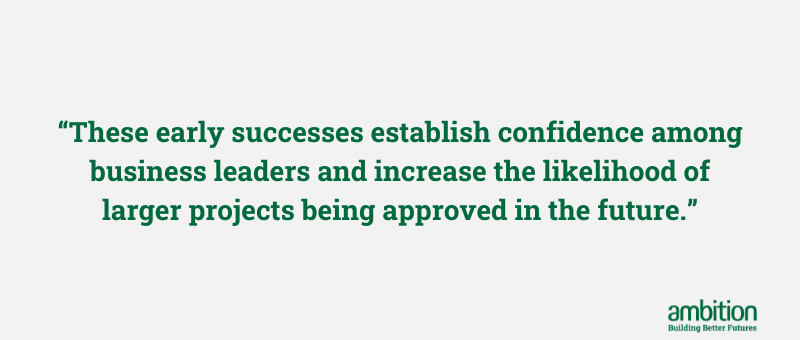Please beware of recruitment scams that are currently targeting jobseekers. Click here for further advice.

Driving executive buy-in for generative AI: Key tips from industry leaders
Given the emergence and potential business value that generative AI can provide, it's critically important for data and analytics leaders to understand how to drive executive buy-in and promote the adoption of these new technologies in today's market. Recently, we've had conversations with leaders in the field who shared some key strategies for successfully gaining executive support for their projects. Here are the insights they provided:
1. Operate with a Startup Mindset
One of the most effective strategies is to operate with a startup/resourceful mindset. Instead of building large, complex, and expensive proof of concept, encourage a test-and-learn environment within your organisation and team. That way, prior to pitching to executives, you can bring examples of where you’ve already added value to the business and have conversations around scalability/implementation, instead of theoretical value. Here's how you can do that:

Be resourceful
Allocate a small number of internal resources to high-value, low-risk applications. This minimises expenses, maximises value, and promotes a culture of innovation, benefiting employee retention. Utilise cross-functional teams to leverage diverse skills and perspectives, and seek out inexpensive or open-source tools to reduce costs. Encourage team members to think creatively and come up with innovative solutions that can be tested quickly without significant investment.
Quick wins
Launch smaller projects early to quickly build positive momentum. These early successes establish confidence among business leaders and increase the likelihood of larger projects being approved in the future. Focus on areas where AI can have an immediate impact, such as automating routine tasks or enhancing customer experiences. Celebrate these quick wins publicly within the organisation to showcase the tangible benefits of generative AI and generate excitement among stakeholders.
Drive momentum
Accumulating quick wins establishes a track record of success, driving further adoption and confidence in generative AI projects among business leaders. Use the credibility gained from initial successes to secure buy-in for more ambitious projects. Create a roadmap that outlines the long-term vision for AI adoption, and communicate this vision regularly to keep stakeholders engaged. Provide ongoing training and support to ensure that teams are equipped to scale AI initiatives effectively.
2. Marry Technology to the Business Case
Another crucial tip is to tightly integrate technology initiatives with the business case. AI technology is challenging to understand, especially as it’s accompanied by a fear of replacing jobs. This fear and lack of understanding can cause a real hurdle in driving AI adoption. Therefore, when pitching to stakeholders, it’s important to keep conversations focused on the benefit the technology is going to provide to the business function, as opposed to getting bogged down in technical detail. This can be done by:
Understanding business problems
Thoroughly understand the core business problems each internal team faces. Attend business leadership meetings and engage with different functions to grasp the nuances of their challenges. Conduct in-depth interviews and workshops with key stakeholders to identify pain points and areas where AI can add value. Map out the customer journey and pinpoint opportunities for AI to improve efficiency and outcomes.

Assess value
Evaluate the potential value of an initiative before investing in its development. Ensure the solution outweighs the cost of the technology. This alignment ensures projects genuinely provide tangible commercial value. Develop a robust business case that includes ROI calculations, cost-benefit analysis, and risk assessments. Prioritise projects that align with strategic goals and have clear, measurable outcomes.
Build valuable products
By understanding the specific needs and nuances of each user’s problems, build products that deliver significant commercial value. Engage end-users early in the development process to gather feedback and iterate on solutions. Design user-centric AI applications that are intuitive and easy to adopt. Monitor and measure the impact of AI solutions continuously, and make data-driven adjustments to enhance their effectiveness.
3. Build Relationships with Technology Vendors
To maximise your business's AI capability, it’s important to build strong relationships with your tech vendors. Providing value to vendors can result in accessing AI tools at a lower price, making pitches more attractive to business leaders. Provide value by:
Referring Customers: Refer customers to the vendor. Act as a partner in promoting the vendor's solutions within your network, and collaborate on joint marketing efforts. Share success stories and case studies that highlight the benefits of the vendor's technology, helping to build their credibility and customer base.
Providing Case Studies: Engage in creating case studies for the vendor. Document successful AI implementations and their impact on your business. Work with the vendor to publish these case studies in industry journals, conferences, and webinars. This not only helps the vendor but also positions your organisation as a leader in AI adoption, attracting further interest and investment from executives.
In conclusion
Driving executive buy-in for generative AI requires a strategic approach that combines a startup mentality with a deep understanding of business needs. By fostering a test-and-learn environment, achieving quick wins, and aligning technology with business objectives, data and analytics leaders can effectively promote the adoption of generative AI technologies within their organisations.
If you are looking for a market overview or need any assistance in your job search reach out to our team of expert recruitment consultants here.
Other resources:
Recently, Chris Auckland, our Group Managing Director for APAC, hosted an AI event to discuss AI’s potential to boost efficiency, automate tasks, and generate valuable insights, many companies are exploring how to incorporate these capabilities into their operations.
Edited by Melanie Brown, Marketing Executive, Ambition Group Australia.






